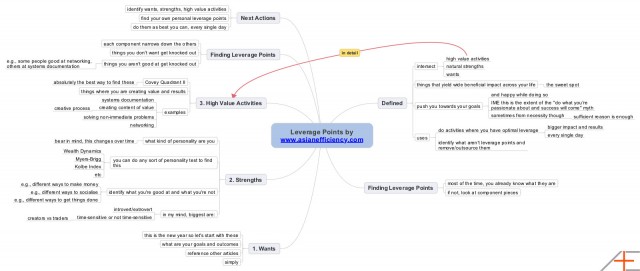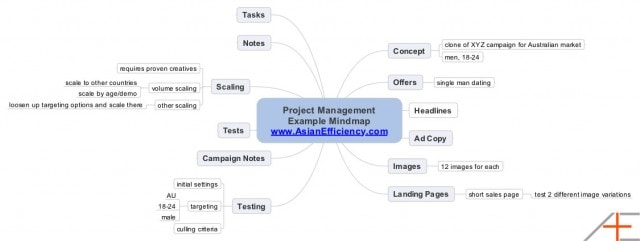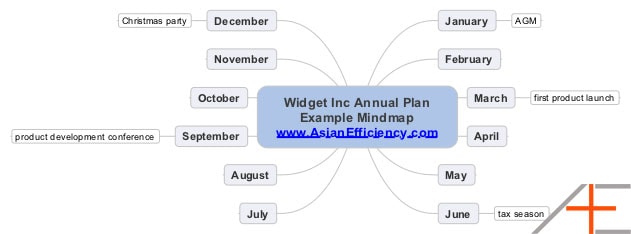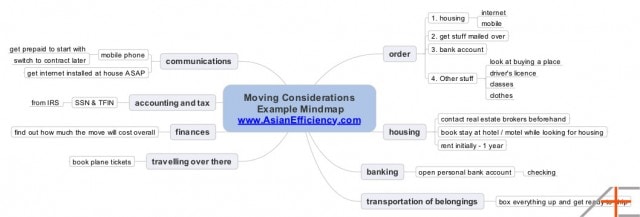
One simple way to extend your understanding and use of mind maps, is to simply use them in different situations and contexts. Here are some simple everyday uses for mind maps (with examples).
Quick Summary
- Think notes, think mind map. This is the best way to find potential mind map uses – think about where you normally take notes, and use a mind map instead.
- The common uses: summaries, brainstorming and ideation, problem solving, content creation, taking notes.
- The less-common uses: project management, planning, analyses and decision making, rapid thought recording.
- Download all the example mindmaps here.
Common Everyday Mind Map Uses
Let’s start with the common uses for mind maps. We’ve talked about some of these before in our comparison of notes and mind maps.
1. Book and Media Summaries
One of the simplest and most effective uses for mind maps is to use them to create summaries for books, audiobooks or any other sort of multimedia course.
Why create book summaries? Because you can review them easily later. It’s much simpler to spend 2-3 minutes flicking through a 1-page mind map that highlights the main concepts of a book (as relevant to you) than to skim-read an entire book again. The process of writing down the main points of a book also helps solidify your own understanding of it.
As an example, here’s a stripped-down copy of one of my own book summaries for The Alchemist, a book we looked at recently.

2. Brainstorming and Ideation
Brainstorming and ideation (idea generation) are the classic use for mind maps. It all begins with a central idea from which subsequent ideas are “generated” and expanded outwards. Thanh has a whole article about how we do this.
Brainstorming with mind maps can be for anything from ideas for your daughter’s birthday party to generating ideas for advertising campaigns.
Here’s an mock-up example of ideas generated via mind map for a fictitious product’s ad campaign.

3. Problem Solving
Mindmaps are often used by students and business teams to help highlight the connections between different parts of a complex problem, leading to a solution.
The process begins by writing down the different aspects of the problem on paper (as agreed upon by yourself or the group/team), then drawing links and expanding details where necessary. As this process is iterated over and over, the problem becomes clearer and a solution becomes apparent.
Here’s a mock-up mindmap that shows different aspects of the E-Myth’s classic whiteboard eraser problem.

4. Content Creation
We’ve mentioned numerous times how we use mind maps to create all our content at Asian Efficiency. Using mind maps to map out content is similar to using mind maps for brainstorming, but with the understanding that the details will be developed into a different medium (essay, article, speech etc).
Our own process at Asian Efficiency begins with a central idea, an outline of first tier nodes and then an expansion of each until the article is “done”.
Here’s an example we’ve shared before, for our article on Leverage Points.

5. Taking Notes
Using mind maps to take notes from a lecture or meeting is probably the most overlooked use of mind mapping, because it isn’t seen as “proper” or “professional”. Think of it as using a mind map to create a book summary, but doing it “live” as other people are conveying information.
Here’s an example of a mind map for meeting notes.

Less Common Uses of Mind Mapping
6. Project Management
Mind maps can be used to plan entire projects.
The best way to demonstrate is via example. Here’s the outline of a mindmap that I created for an online advertising project.

Each of the phases of the project is mapped out clockwise starting at 12 o’clock. There are also nodes available for storing to do items and for notes about the project. And yes, I created this and have used these mind maps even with the “stripped down” Mac version of MindManager – the one that lacks all the “powerful and essential business grade” bells and whistles of the Windows version.
7. Planning
Mind maps can be used to perform both personal and business planning.
In the past, I’ve shown a simple way to use a mind map to plan a personal trip. We’ve also extensively talked about how mind maps are used to formulate outcomes and goals.
You can also use mind maps to formulate business plans, whether for a project (see section above), or for an entire business. Here is an example of an annual plan for the fictitious Widgets Inc.

Bonus: Integrated Analysis and Decision Making
Originally we planned seven examples but we had to include this one – the use of mind maps for analysis and/or decision making. By putting down all the variables and factors about a decision in a visual top-down format, you can see how they all interplay with each other. These mindmaps are similar to those used for problem solving, but there is often a layer of analysis and explanation added through the use of relationships and callouts.
When we do productivity consulting we often map down our analysis as a mind map. You can find out more about how we do that by reading our case studies.
The same format can also be used for decision making. Mind maps allow you to see all the things in play, and can help highlight more and less important factors involved in your decision. Here’s an example.

Next Actions
Download all the example mindmaps here.
We’ve just shared a lot of different ways that you can use mind maps in your everyday life – for work, for planning and for your personal projects. Take some of these uses as inspiration and as templates for your own mind maps.
We do all our mind mapping in Mindjet MindManager – “stripped down” Mac version or otherwise!
Did you like this post? We have some of our best productivity hacks and tips in the Asian Efficiency Primer. Check it out here.
![]()
Photo by: McPig

Hello Team, requesting your assistance in training my kids in mind mapping.
Idea to have kids mind map with what is fun for them at first, to understand how to put down different ideas on paper.
Also try a collage technique, using cut out little pictures (or words) that they can group together on the floor or table (depending on age). They can link them together by pieces of string or yarn. What comes first, then next, then next, etc.
Even for just a few minutes at a time, no right or wrong way when they are experimenting with this for the first few times.
Good article. I read an article once, in which a very smart guy, used mind maps for indexing the content of the (hard copy) books he read for class.
It just happened that in an exam, they were allowed to use the books in the exam, and it was really easy for him to answer the questions as he had all the important content indexed using mind maps.
Thanks Thanh, your maps would be a fantastic addition to the library, and it’s a great way to raise awareness of your website among our users!
Really great article, with some excellent examples maps and explanations of how to use mapping in everyday contexts!
We would love to see your map examples added to the free mind map library at https://www.Biggerplate.com for others to see!
Best wishes,
Liam Hughes
Founder: Biggerplate
Hey Liam thanks for dropping by. Your site looks really interesting and we will probably contribute too.